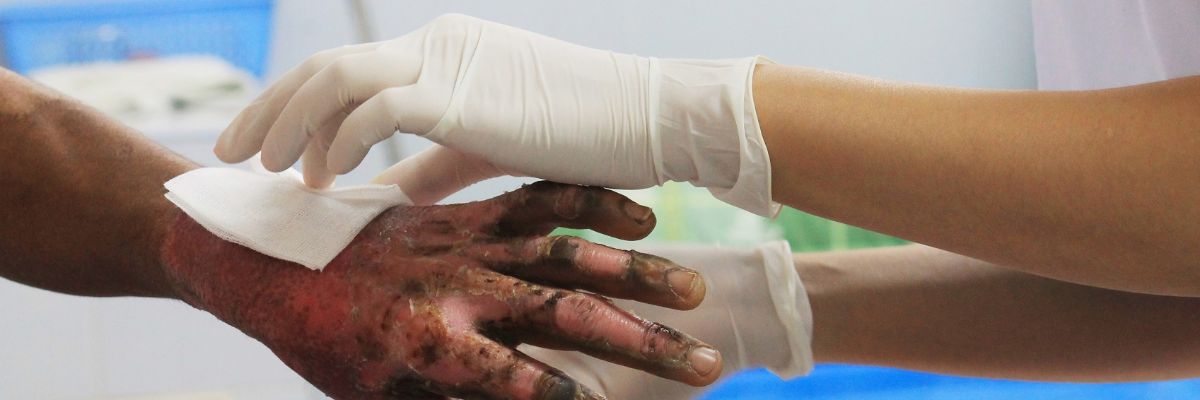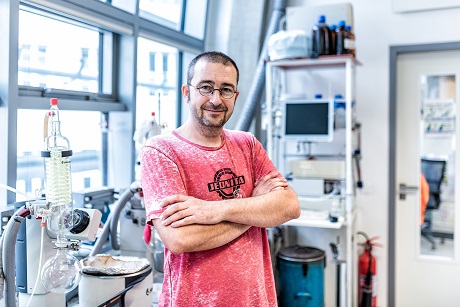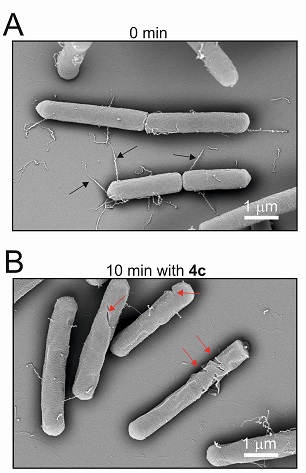
Bandage made from a new nanomaterial will help to heal burns and skin infections
26. 10. 2021
Chemists, microbiologists and engineers from different institutions have joined forces to produce a completely new type of nanomaterial dressing with antibiotic effect. It could find its use in the treatment of burns and skin wounds with bacterial infections. The material, called NANO LPPO, has proved its worth in the first experimental phase, but clinical trials have yet to verify it. The results of the study were published in the Scientific Reports journal.
As more and more strains of bacteria resist conventional antibiotics, chemists are constantly looking for new antibacterial compounds. One of the promising compounds is the so-called lipophosphonoxins (LPPO) developed by the team of Dominik Rejman from the Institute of Organic Chemistry and Biochemistry of the Czech Academy of Sciences (the CAS) in collaboration with Libor Krásný from the Institute of Microbiology of the CAS.

Dominik Rejman leads the group of Antimicrobial Compounds at the IOCB of the CAS
"Lipophosphonoxins represent a great hope for a new generation of antibiotics. They do not need to penetrate the bacteria, but act on the surface where they disrupt the bacterial cell membrane. This makes them capable of killing bacteria efficiently and quickly," says Dominik Rejman. Their great advantage is that bacteria do not get used to them easily. "In an experiment lasting several weeks, we did not find bacteria resistant to these substances, whereas resistance to known antibiotics was relatively easy to develop," adds Libor Krásný.
Fibers against bacteria
LPPO substances have potential especially where immediate targeted intervention is needed - for example, in the case of the aforementioned skin infections. But how to apply them to the wound? For practical use, it was necessary to find a suitable material to apply LPPO to the skin. The solution was offered by polymer nanofibers developed in the team of David Lukáš from the Technical University of Liberec.
The treatment is supposed to work by breaking down the nanomaterial into harmless molecules by the action of enzymes, with the LPPO being a solid part of it and released from it just as it breaks down. Moreover, this breakdown is supposed to be greatly accelerated in the presence of bacteria that produce degrading enzymes. "This means that the more bacteria there are in the wound, the faster the material will decompose, and the more active substances will be released into the affected area to promote healing and soft tissue regeneration," adds Dominik Rejman.

Bacillus subtilis bacteria before and after application of LPPO agents. The second image shows significant damage to the bacteria after only ten minutes.
The ability of NANO LPPO to prevent wound infections and accelerate healing has been verified by experiments in mice models. "Where we used them, the spread of infection was virtually non-existent. If the clinical trials turn out well, this could mean a major advance in the treatment of burns and other serious injuries where infections pose an acute threat and a serious complication of treatment," adds wound healing expert Peter Gál from the UK's 3rd Faculty of Medicine.
From the application point of view, the NANO LPPO material is interesting to manufacturers of pharmaceuticals and medical devices. IOCB TECH (a subsidiary of the Institute of Organic Chemistry and Biochemistry of the CAS) and Charles University Innovations Prague (a subsidiary of the UK) are now collaborating to put it into practice.
Text: Leona Matušková, Division of External Relations, CAS Centre of Administration and Operations
Photo: Shutterstock; Tomáš Belloň, IOCB Prague; Institute of Microbiology of the CAS
Read also
- A trapped state: The pandemic impact on public attitudes, trust, and behavior
- Aerial archaeology: Tracing the footsteps of our ancestors from the sky
- Archaeologists uncover ancient finds along Prague Ring Road
- Our microbiome largely depends on what we eat, says microbiologist Michal Kraus
- The ABCs of writing: Why did its invention mark a turning point for humankind?
- We learn, remember, forget… What can memory actually do? And can we outsmart it?
- New Center for Electron Microscopy in Brno opens its doors to global science
- The hidden lives of waste: What can we learn from waste workers and pickers?
- A unique lab is hidden right beneath Prague’s Vítkov Hill
- Renewables are a strategic investment in European security, scientists say
The Czech Academy of Sciences (the CAS)
The mission of the CAS
The primary mission of the CAS is to conduct research in a broad spectrum of natural, technical and social sciences as well as humanities. This research aims to advance progress of scientific knowledge at the international level, considering, however, the specific needs of the Czech society and the national culture.
President of the CAS
Prof. Eva Zažímalová has started her second term of office in May 2021. She is a respected scientist, and a Professor of Plant Anatomy and Physiology.
She is also a part of GCSA of the EU.